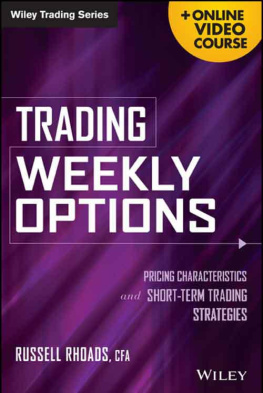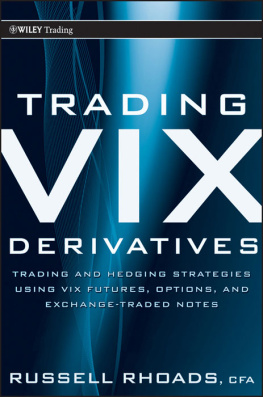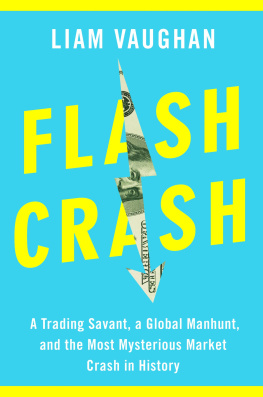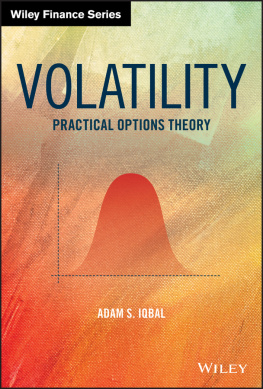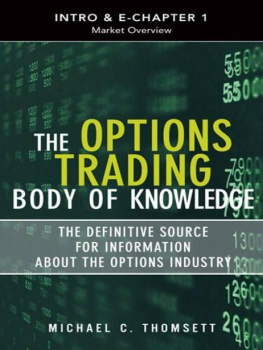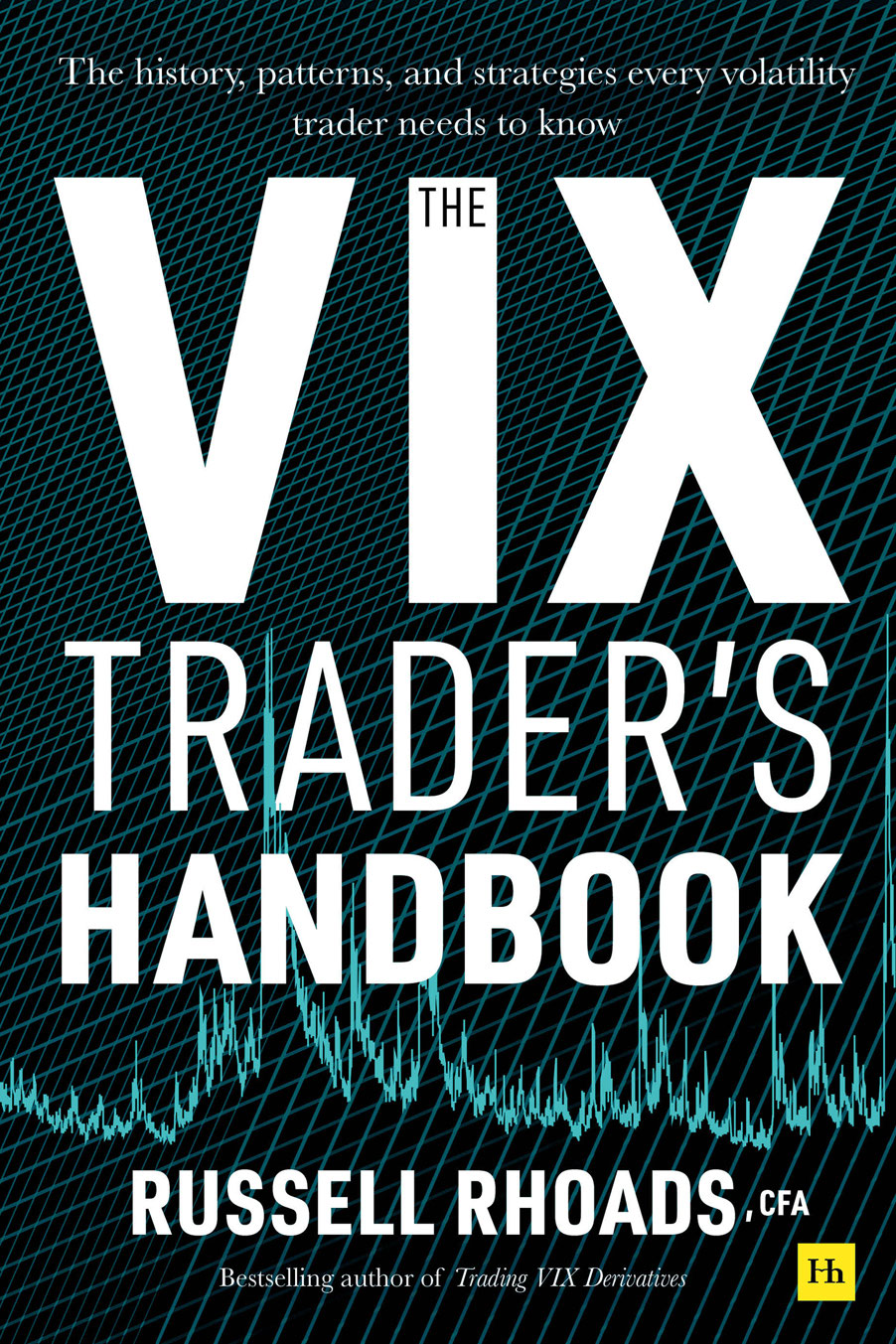The VIX Traders Handbook
The history, patterns, and strategies every volatility trader needs to know
Russell Rhoads
Contents
About the author
Russell Rhoads
is a highly regarded strategist, educator and consultantamong other things he is perhaps best known as the author of Trading VIX Derivatives, the textbook in the volatility space. He works for EQDerivatives and is a clinical professor of finance at Loyola University in Chicago.
Russell spent a decade at CBOE, including a stint as director of education at The Cboe Options Institute. He has a 25-year career, which includes buyside firms such as Balyasny Asset Management, Caldwell & Orkin, and Millennium Management.
Russell is pursuing a PhD from Oklahoma State University.
Introduction
I
n 2009
I became an instructor for the Options Institute at what was the Chicago Board Options Exchange (now Cboe Global Markets). None of the other instructors were paying much attention to VIX as the volume had not really taken off.
I decided to immerse myself in all things VIX. This was impeccable timing on my part as the markets were starting to emerge from the depths of the Great Financial Crisis. This was a period where VIX was front and center in the financial press as a quantification of how much fear there was in the markets.
My focus on VIX led to courses being developed at the Options Institute to specifically focus on using VIX as a market indicator, but also strategies associated with VIX futures and option contracts. Shortly before I joined Cboe, the first two exchange-traded notes based on the performance of VIX futures contracts were introduced. Although this was not a Cboe-specific market or product, I felt that focusing on and promoting these other methods of gaining exposure to the markets expectations for volatility was good for the emergence of volatility as a tradable asset. Another part of my becoming an authority on VIX involved writing a book. If you want to learn about something, write a book, it definitely will make you an expert.
My first book on VIX, Trading VIX Derivatives, is now a decade old. In 2009, when I wrote the book, average daily VIX futures volume was 32,000 and average daily VIX option volume was 132,000. In 2019, these average daily volume totals had increased to 248,000 and 502,000 respectively. Also, there were only two exchange-traded products available back in 2009 (VXX and VXZ). There are now 10 actively traded volatility-linked ETPs (exchange-traded products) in the US, a number that was in the mid-20s at its peak. It is an understatement to say that things have changed a bit since I wrote that first VIX book. I will also fully admit I have learned a lot over the past decade.
This book tries to appeal to all levels of market participants, from those that want to just have an understanding of how VIX and the related trading products behave, to those that may want to hedge equity exposure or take advantage of the persistent overpricing of option volatility. Also, I try to be very modular in the way I present material, which means if you are thinking about trading VIX ETPs you can jump straight to Chapter 3. If shorting a volatility spike is your area of interest, you can turn directly to Chapter 7.
How this book is structured
This book is divided into three parts.
Part I consists of five chapters which discuss the basics of VIX, the various related trading instruments, and some markets where exposure to other volatility indexes can be traded. Chapter 5 takes a deep dive into historical price action of VIX.
Part II, covering Chapters 6 to 10, discusses the trade construction process and the various strategies that volatility traders implement in order to gain both short and long exposure to VIX.
Part III, Chapter 11, is a history lesson discussing volatility events stretching all the way back to the 1987 crash.
Part I
Chapter 1
Offers a brief introduction to VIX, what it is telling us and a high-level look at how it is calculated. Theres also a little on why VIX has an inverse relationship with the S&P 500.
Chapter 2
Introduces VIX options and futures, which trade at the Cboe option exchange and Cboe futures exchange respectively. Their unique price behavior is introduced, along with an explanation of why the futures trade independently of spot VIX.
Chapter 3
This chapter covers the variety of volatility-related ETPs that are available for trading. This has been an area of controversy in the financial markets, mostly due to a misunderstanding of what these products offer. Despite the misunderstandings and constant bashing, as I write this the largest ETN (exchanged-traded note) based on AUM (VXX) has about $730 million in assets under management with over $2 billion invested in the variety of volatility-linked ETPs.
Chapter 4
Introduces tradable volatility markets that exist alongside VIX. The number two market in the volatility space is VSTOXX, which is the expected volatility of the Euro STOXX 50 index as indicated by options trading on that market. A very accurate short name for this market is the European VIX.
Chapter 5
A quantitative history lesson on VIX. Many market participants have short memories or have not been in the investment business long enough to fully recall VIX during periods of high or low volatility regimes. Additionally, this chapter looks at VIX versus the futures contracts, as well as how well the ETPs react relative to VIX and S&P 500 price action.
Part II
Chapter 6
When planning a derivative trade there are many moving parts. This is accentuated in the VIX world as the initial underlying is the S&P 500, then we look to VIX, then to the current anticipation that is present in VIX futures. Planning a VIX-related trade and choosing the best method to implement an outlook is a process that differs from most other markets. This chapter lays out what to consider before pulling the trigger.
Chapter 7
The first of two chapters that address being short volatility. The first look at being short volatility addresses consistent methods of taking advantage of the volatility risk premium that is available from VIX-related trading products.
Chapter 8
This second chapter on being short volatility addresses taking the other side of volatility spikes and how this has worked in the past. Selling into a volatility spike can be a white-knuckle experience for traders, but as with any very risky prospect, this can be a rewarding trading method.
Chapter 9
Shorting volatility is what the majority of professionals think of with respect to VIX. However, the headlines associated with VIX are often related to the large moves that accompany a drop in the stock market. Being long volatility is a costly venture if it does not work out perfectly, but there are still effective means for being long volatility that can be implemented at a reasonable price.
Chapter 10
This final chapter on trading strategies addresses spread trading between different VIX futures expirations as well as trading VSTOXX futures versus VIX. Using options and even ETPs based on the same sort of outlook is addressed as well.


